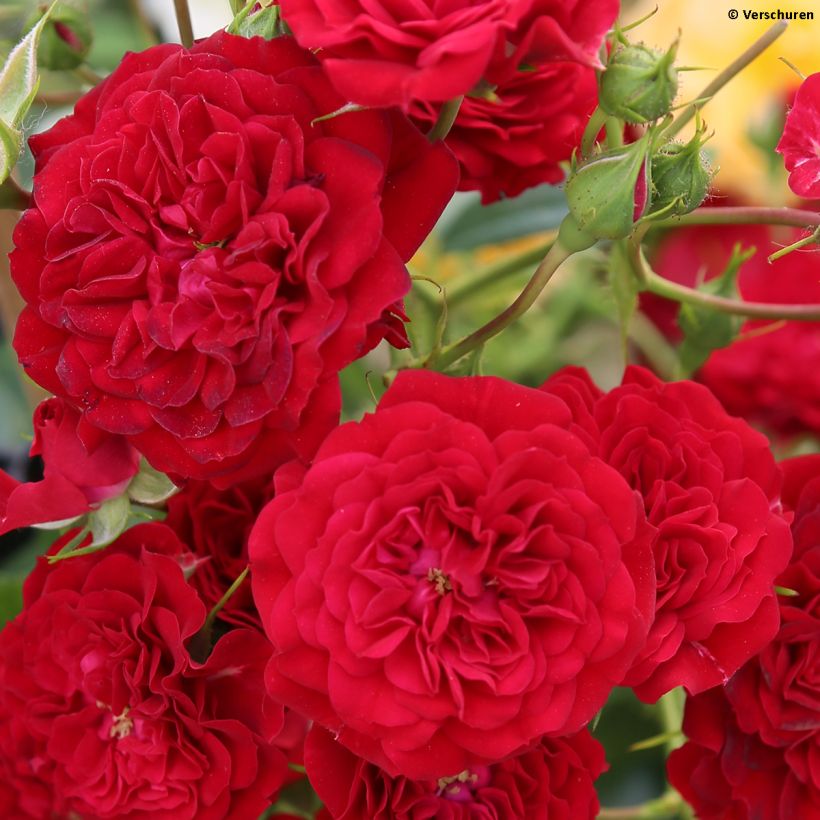

Rosa 'Crimson Siluetta' - Climbing Rose
Rosa 'Crimson Siluetta' - Climbing Rose
Rosa Crimson Siluetta® 'KORsilu06'
KORsilu06
Special offer!
Receive a €20 voucher for any order over €90 (excluding delivery costs, credit notes, and plastic-free options)!
1- Add your favorite plants to your cart.
2- Once you have reached €90, confirm your order (you can even choose the delivery date!).
3- As soon as your order is shipped, you will receive an email containing your voucher code, valid for 3 months (90 days).
Your voucher is unique and can only be used once, for any order with a minimum value of €20, excluding delivery costs.
Can be combined with other current offers, non-divisible and non-refundable.
Home or relay delivery (depending on size and destination)
Schedule delivery date,
and select date in basket
We guarantee the quality of our plants for a full growing cycle, and will replace at our expense any plant that fails to recover under normal climatic and planting conditions.
Description
The Climbing Rose 'Siluetta Crimson' is part of the Siluetta series, a line of roses developed in Germany by Kordes for their compact habit as they reach a maximum height of 2m (7ft). Very recurrent, their floribundance is only matched by their robustness and disease resistance. This variety 'Crimson' announces its presence with its splendid crimson red flowering. Its flowers have the appearance of old roses: with their numerous tightly packed petals, they form very double roses, slightly fragrant, abundantly present along the flexible stems, creating a beautiful contrast with the dark green satin foliage.
The 'Crimson Siluetta' Rose 'KORsilu06' is a highly recurrent climbing rose that appeared on the European market in 2019. This cultivar won the gold medal at the Baden-Baden International Rose Competition 2019. Vigorous, it has a flexible habit and thorny stems, reaching 2m (7ft) in height and 70cm (28in) in width. Its foliage, free from spots, perfectly showcases the beautiful clusters of small 4cm (2in) flowers of intense red. It blooms almost continuously, from May to September, abundantly, as long as it does not lack water. Its flowers are double, globular, with tightly packed petals. Their fragrance, fresh and light, belongs to wild roses.
The 'Siluetta' roses are suitable for covering a fence, a pergola, or a trellis on a wall. They allow for the creation of modest but sumptuous decorations throughout the summer. They require very little maintenance, except for regular watering in summer in case of high heat and prolonged drought. Mix them or combine them with easy-to-grow large-flowered clematis like 'Broughton Star'. They are good companions for paniculate phlox, delphiniums, foxgloves, catmints, and tall baby's breath. The 'Crimson' variety can be combined in contrast with large blue salvias or with foliage climbers like the Virginia creeper. It also elegantly dresses up a balcony in a large pot exposed to partial shade.
Report an error about the product description
Rosa 'Crimson Siluetta' - Climbing Rose in pictures




Plant habit
Flowering
Foliage
Botanical data
Rosa
Crimson Siluetta® 'KORsilu06'
Rosaceae
KORsilu06
Cultivar or hybrid
Planting and care
Plant the 'Siluetta Crimson' rose from November to March in ordinary, well-prepared and well-drained soil. Roses prefer clay soil that is rather heavy than light. In soil that is too sandy, too compact or too dry in summer, it is preferable to bury compost or well-rotted manure at the bottom of the planting hole. However, this rose is afraid of waterlogged soil in winter. Plant it in a sunny location or, at most, in partial shade. Roses are greedy plants, so a specific rose fertiliser will be beneficial at the start of growth and regularly throughout the flowering period. To encourage new blooms, regularly remove faded flowers. In late winter, prune the stems by about a quarter of their length (from 4 to 6 buds from the base of the stem). Always prune above an outward-facing bud so that the bush can grow and the branches do not become tangled in the centre of the branches.
Roses may appear stained or unsightly at the end of summer. However, it is a natural phenomenon that doesn't harm their development.
Planting period
Intended location
Care
This item has not been reviewed yet - be the first to leave a review about it.
Similar products
Haven't found what you were looking for?
Hardiness is the lowest winter temperature a plant can endure without suffering serious damage or even dying. However, hardiness is affected by location (a sheltered area, such as a patio), protection (winter cover) and soil type (hardiness is improved by well-drained soil).

Photo Sharing Terms & Conditions
In order to encourage gardeners to interact and share their experiences, Promesse de fleurs offers various media enabling content to be uploaded onto its Site - in particular via the ‘Photo sharing’ module.
The User agrees to refrain from:
- Posting any content that is illegal, prejudicial, insulting, racist, inciteful to hatred, revisionist, contrary to public decency, that infringes on privacy or on the privacy rights of third parties, in particular the publicity rights of persons and goods, intellectual property rights, or the right to privacy.
- Submitting content on behalf of a third party;
- Impersonate the identity of a third party and/or publish any personal information about a third party;
In general, the User undertakes to refrain from any unethical behaviour.
All Content (in particular text, comments, files, images, photos, videos, creative works, etc.), which may be subject to property or intellectual property rights, image or other private rights, shall remain the property of the User, subject to the limited rights granted by the terms of the licence granted by Promesse de fleurs as stated below. Users are at liberty to publish or not to publish such Content on the Site, notably via the ‘Photo Sharing’ facility, and accept that this Content shall be made public and freely accessible, notably on the Internet.
Users further acknowledge, undertake to have ,and guarantee that they hold all necessary rights and permissions to publish such material on the Site, in particular with regard to the legislation in force pertaining to any privacy, property, intellectual property, image, or contractual rights, or rights of any other nature. By publishing such Content on the Site, Users acknowledge accepting full liability as publishers of the Content within the meaning of the law, and grant Promesse de fleurs, free of charge, an inclusive, worldwide licence for the said Content for the entire duration of its publication, including all reproduction, representation, up/downloading, displaying, performing, transmission, and storage rights.
Users also grant permission for their name to be linked to the Content and accept that this link may not always be made available.
By engaging in posting material, Users consent to their Content becoming automatically accessible on the Internet, in particular on other sites and/or blogs and/or web pages of the Promesse de fleurs site, including in particular social pages and the Promesse de fleurs catalogue.
Users may secure the removal of entrusted content free of charge by issuing a simple request via our contact form.
The flowering period indicated on our website applies to countries and regions located in USDA zone 8 (France, the United Kingdom, Ireland, the Netherlands, etc.)
It will vary according to where you live:
- In zones 9 to 10 (Italy, Spain, Greece, etc.), flowering will occur about 2 to 4 weeks earlier.
- In zones 6 to 7 (Germany, Poland, Slovenia, and lower mountainous regions), flowering will be delayed by 2 to 3 weeks.
- In zone 5 (Central Europe, Scandinavia), blooming will be delayed by 3 to 5 weeks.
In temperate climates, pruning of spring-flowering shrubs (forsythia, spireas, etc.) should be done just after flowering.
Pruning of summer-flowering shrubs (Indian Lilac, Perovskia, etc.) can be done in winter or spring.
In cold regions as well as with frost-sensitive plants, avoid pruning too early when severe frosts may still occur.
The planting period indicated on our website applies to countries and regions located in USDA zone 8 (France, United Kingdom, Ireland, Netherlands).
It will vary according to where you live:
- In Mediterranean zones (Marseille, Madrid, Milan, etc.), autumn and winter are the best planting periods.
- In continental zones (Strasbourg, Munich, Vienna, etc.), delay planting by 2 to 3 weeks in spring and bring it forward by 2 to 4 weeks in autumn.
- In mountainous regions (the Alps, Pyrenees, Carpathians, etc.), it is best to plant in late spring (May-June) or late summer (August-September).
The harvesting period indicated on our website applies to countries and regions in USDA zone 8 (France, England, Ireland, the Netherlands).
In colder areas (Scandinavia, Poland, Austria...) fruit and vegetable harvests are likely to be delayed by 3-4 weeks.
In warmer areas (Italy, Spain, Greece, etc.), harvesting will probably take place earlier, depending on weather conditions.
The sowing periods indicated on our website apply to countries and regions within USDA Zone 8 (France, UK, Ireland, Netherlands).
In colder areas (Scandinavia, Poland, Austria...), delay any outdoor sowing by 3-4 weeks, or sow under glass.
In warmer climes (Italy, Spain, Greece, etc.), bring outdoor sowing forward by a few weeks.








































